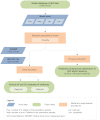The distribution of haemoglobin C and its prevalence in newborns in Africa
- PMID: 23591685
- PMCID: PMC3628164
- DOI: 10.1038/srep01671
The distribution of haemoglobin C and its prevalence in newborns in Africa
Abstract
Haemoglobin C (HbC) is one of the commonest structural haemoglobin variants in human populations. Although HbC causes mild clinical complications, its diagnosis and genetic counselling are important to prevent inheritance with other haemoglobinopathies. Little is known about its contemporary distribution and the number of newborns affected. We assembled a global database of population surveys. We then used a Bayesian geostatistical model to create maps of HbC frequency across Africa and paired our predictions with high-resolution demographics to calculate heterozygous (AC) and homozygous (CC) newborn estimates and their associated uncertainty. Data were too sparse outside Africa for this methodology to be applied. The highest frequencies were found in West Africa but HbC was commonly found in other parts of the continent. The expected annual numbers of AC and CC newborns in Africa were 672,117 (interquartile range (IQR): 642,116-705,163) and 28,703 (IQR: 26,027-31,958), respectively. These numbers are about two times previous estimates.
Figures




References
-
- Bain B. J. Haemoglobinopathy Diagnosis. Second edn, (Blackwell Publishing Ltd, 2006).
-
- Livingstone F. B. Frequencies of Hemoglobin Variants: Thalassemia, the Glucose-6-Phosphate Dehydrogenase Deficiency, G6Pd Variants and Ovalocytosis in Human Populations. (Oxford University Press, 1985).
Publication types
MeSH terms
Substances
Grants and funding
LinkOut - more resources
Full Text Sources
Other Literature Sources

